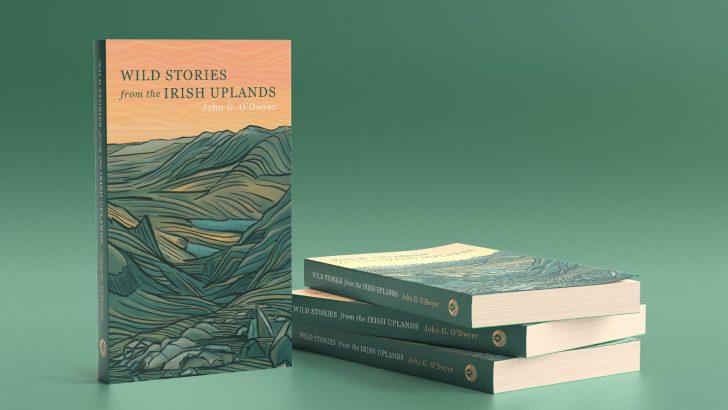Wild Stories from the Irish Uplands
by John G. O’Dwyer (Currach Books, €14.99)
The author is a veteran hiker with over thirty years experience of leading walking and mountaineering groups through the Irish countryside. In this collection of essays he visits a number of well-known uplands across the country and recalls their association with historical figures and events.
Beginning with St Patrick, he surveys Slemish in Co. Antrim. Here the kidnapped youth was employed as a shepherd on its slopes by Milchu, a slave owner. O’Dwyer next ascends the Hill of Slane, where St Patrick with his Paschal Fire posed an unmistakeable challenge to the pagan Irish High King on the nearby Hill of Tara.
Next he traces the saint’s footsteps to Croagh Patrick, on the summit of which St Patrick reputedly fasted for forty days. The author provides a detailed account of the ascent and notes that, despite the hardship involved, the pilgrimage mountain is climbed about one hundred thousand times annually, with the last Sunday in July the most popular day on which to ‘Climb the Reek’.
Footsteps
The author does not restrict his retracing of the footsteps of St Patrick to high ground and includes in his itinerary Station Island in Lough Derg, the Rock of Cashel and Ardpatrick in Co Limerick, where according to tradition, St Patrick established his first monastic settlement.
Mount Brandon in the Dingle peninsula is named after St Brendan. He is also known as the ‘Navigator’ and the author visits Brandon Creek, whence, according to legend, the saint successfully crossed the North Atlantic.
Tim Sevrin will forever be associated with St Brendan and his search for the ‘Island promised to the saints’.
Convinced that St Brendan’s voyage was based on fact, he built a replica of St Brendan’s currach, using the materials and techniques of the period. After a hazardous journey which involved serial island hopping and landfall in a number of other places Sevrin and his four companions reached Newfoundland.
However, not-withstanding Sevrin’s remark-able achievement, Dwyer rejects his claim to have proved that St Brendan was the first European to reach America.
The Wicklow mountains provide O’Dwyer with the location for more of his ‘wild stories’. The Ulster princes Red Hugh O’Donnell and Art O’Neill escaped from Dublin Castle on the night of January 6, 1592. They reached the Dublin mountains and thence were led by a guide in inclement weather conditions through the Wicklow Gap to the safety of Fiach McHugh O’Byrnes’ Ballinacor Castle in Glenmalure.
Two hundred years later these Wicklow hills were the stronghold of Michael O’Dwyer. Following the suppression of the 1798 rebellion, he refused to surrender to the authorities and continued to harass the crown forces, earning the soubriquet the ‘Outlaw of Glenmalure’.
Although none of his attacks on the ‘Red Coats’ were militarily significant, he was a huge irritant to the administrators of English rule in Ireland.
Construction
To cope with him and other rebels in the area they constructed the Military Road across the Wicklow Hills, with barracks at Glencree, Glendalough, Glenmalure (Drumgoff) and Aughavannagh. By the time the construction of the road was completed in 1809 the entire project had become obsolete.
The threat of a French invasion had receded and O’Dwyer had negotiated terms with the authorities and eventually had been banished to New South Wales in Australia.
The author recalls a significant historical event which occurred on the slopes of the Knockmealdown Mountains on April 10, 1923. While General Liam Lynch and other leaders of the Anti-Treaty movement were fleeing encirclement by the Irish Free State army, Lynch was fatally wounded during an exchange of fire. Within days the Civil War ended.
This book is very much in tune with the zeitgeist of our time, with its responsible obsession with ecology”
From first-hand experience the author discusses various ways in which Carrantuohill could and should be climbed. In so doing he describes some of the heroic rescues conducted on it by Con Moriarty and the Kerry Mountain Rescue Team –wonderful people.
This book is very much in tune with the zeitgeist of our time, with its responsible obsession with ecology. Written with the same fervour with which Pope Francis drafted Laudato Si’, it is replete with information useful to hill-walkers and mountaineers and it is a very interesting read.
Visit here for more information on the book.




